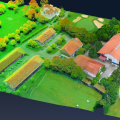
Scientists in New Zealand are using new techniques to interpret the history of undersea earthquakes occurring on major fault lines around New Zealand.
The researchers are using acoustic soundings to analyse the history of undersea fault’s activity.
Investigation of faults on land and what they reveal about their earthquake history is an established discipline, but similar research on submarine faults is limited at best.
The project will help scientists determine the likelihood of damaging earthquakes from underwater faults close to the coast, according to the National Institute of Water and Atmospheric Research principal scientist Philip Barnes.
“We are developing new ways of finding past earthquakes in the submarine realm. It’s the first time we have been able to do this. And in time these approaches will likely be used widely throughout the world,” he said.
The research was presented at the European Science Foundation conference last week.
It focused on the Wairau Fault, which is the northern part of the Alpine Fault, together with the Cloudy and Vernon undersea faults in the Cook Strait.
Instruments are towed in the water to provide recordings of sound reflected from sea-floor layers indicating where the faults are.
By merging this information with similar records from on land, the scientists can learn how the different faults interrelate with each other.
This information contributes to New Zealand’s seismic hazard model, which feeds into structural design standards for New Zealand building codes.
The work was funded by the Foundation for Research, Science and Technology with support from the Earthquake Commission (EQC), Accident Compensation Corporation (ACC), and Wellington City Council (WCC).







